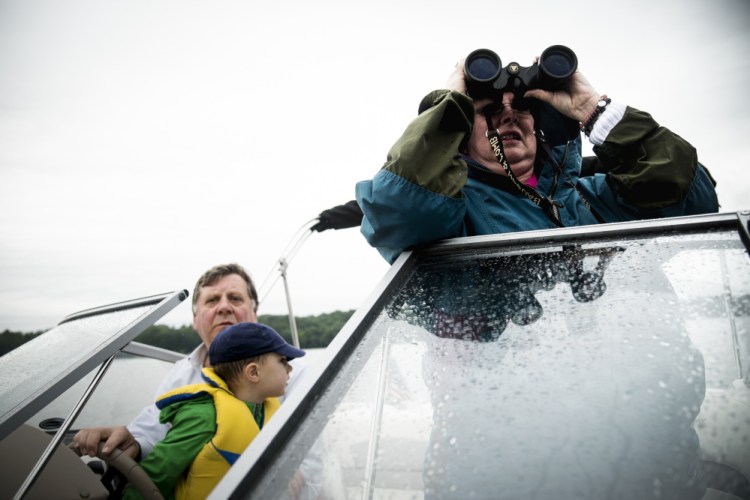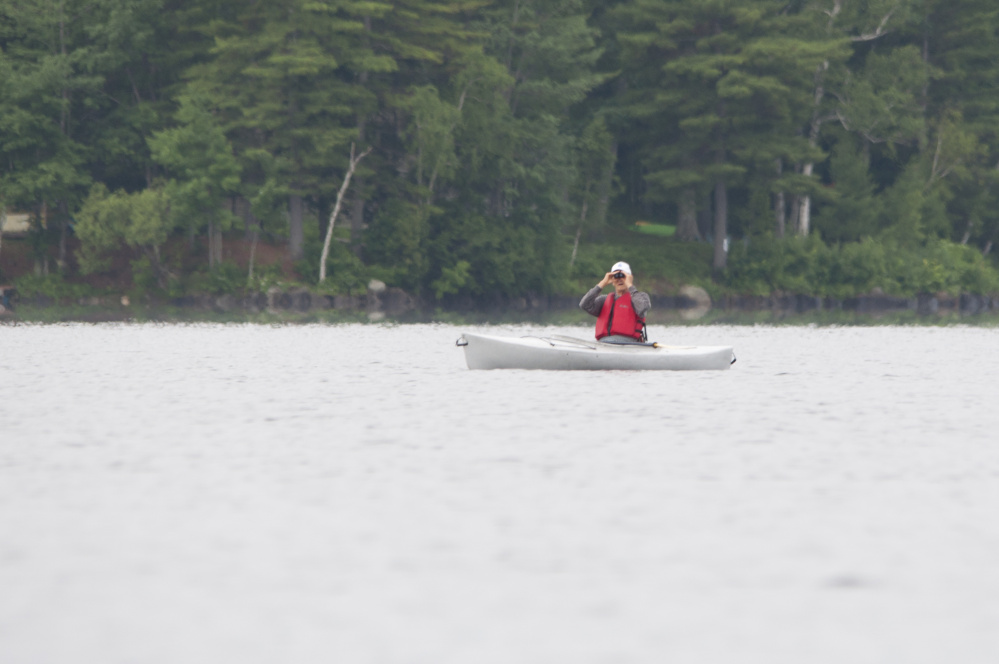CHINA — It’s 6:30 a.m. Saturday and all is quiet on China Lake as Norval and Karen Garnett and their grandson, Calder Amoroso, 2, climb into their 18-foot Stingray power boat to take part in the 34th annual Loon Count sponsored by Maine Audubon.
The Rhode Island family has summered on Killdeer Point for many years and loves the loons, and they want to help ensure that the birds thrive and multiply on the lake.
“The neat thing about loons is they’re so prehistoric,” said Norval Garnett, who is known to friends and family as Tad. “I think they’re the only birds that have solid bones.”
He and his wife teach Calder about loons and the importance of ensuring their survival.
“We show him books and teach him the sounds — the different calls,” said Karen Garnett, who is a third-grade teacher in Rhode Island.
They motored out of the cove under an overcast sky and head southwest to the section of the lake they are assigned to cover — the southern tip — which is 1.5 miles away. As they cruise slowly along, they spot a loon. While it is not in their territory, they document it and will submit the number in case the person who counts in that area doesn’t see it.
Last year, their first year of taking part in the loon count, the Garnetts counted 11 loons, though they counted on a different segment of the lake, which is divided into seven counting sections. On Saturday, the one out of their area was the only loon they saw.
Last year, volunteers on China Lake counted 40 adult loons and two chicks, which is about average for the lake, according to Bob O’Connor’s annual loon count message in the 2017 China Lake Association summer newsletter.
Results of the 2017 count will be presented July 22 at the annual Lake Association meeting and will be available on the association’s website, www.chinalakeassociation.org/loon.
The statewide count in 2016 was estimated at 2,848 adults and 384 chicks at more than 300 lakes in Maine. The 2015 estimate was 2,817 adults — 7 percent lower than the average of the previous five years, according to O’Connor. He said, however, that the long-term trend is positive.
Susan Gallo, wildlife biologist and director of the Maine Loon Project, will be the keynote speaker at the association meeting.
The Garnetts were among more than 850 volunteers who surveyed lakes and ponds around Maine from 7 a.m. to 7:30 a.m. Saturday, counting loons and collecting valuable scientific data to support conservation efforts, according to Maine Audubon officials.
Some counters did so from the shore, while others went by boat. Regional coordinators will compile the results and send them to Maine Audubon, which promotes conservation, educates people about loon biology and conservation and collects scientific data required to advocate for public policies that benefit loons and the lakes they inhabit.
Loons are the best indicators of lake health, according to Gallo, because the birds depend on lakes with clean, clear water and a lot of fish.
“A lake that’s good for loons is good for everyone — all kinds of wildlife, as well as for people, too,” Gallo said in an Audubon news release. “This annual count has helped build public awareness about the important role these iconic birds play in Maine. The data it yields has also built critical support for laws that keep our lakes and loons healthy, including regulations around lead free tackle, shoreline development and invasive plants. Not to mention that, for 34 years, the count has been a great way to get people outside onto Maine’s lakes, learning about where loons are, where they nest and how easy it is to share a lake with a loon family.”
The Garnett family takes its counting job seriously. They had neighbors who counted for Audubon and decided to join last year.
“It just sounded like a good thing to do,” Norval Garnett said.
As Karen Garnett used binoculars to search for loons and checked information on a sheet of paper provided by Audubon, she said officials want to know whether counters see loons in a nest or in the water, how far away they are from the counter, whether they are adults or chicks and what the weather is like.
Garnett, 60, said she enjoys participating in the count.
“It makes you feel like you’ve done something positive for the community.”
As they motored along, they spotted great blue herons — one perched on a tree branch and another on a diving platform. They also saw a cormorant on a dory. Some areas of the lake are more populated with camps and cottages, while others are wilder, with towering pines and thick vegetation.
“We’ve got bald eagles at the end of Killdeer point,” Karen said.
It was Calder’s first time doing the loon count with his grandparents. He is named after artist Alexander Calder, his grandfather said.
“They nest right near the edge of the water,” Norval Garnett said of the loons. “They can’t walk so that nest has to be right on the water. There’s Jones Brook down here, and there used to be a nest right in the middle. They built it on weeds, reeds and sticks.”
“You could see it from the road,” Karen Garnett added. “Everyone would stop to look.”
At that point, the boat was near Route 3, although the highway is hidden from view by trees and brush.
A few raindrops started to fall, and soon it turned into a downpour. Norval Garnett raised a canopy, which covered part of the boat. Karen Garnett wrapped Calder in a soft blanket that had monkey faces on it and put a small blue baseball cap on his head. He sat in his grandfather’s lap and soon fell asleep.
Norval Garnett, 63, retired after publishing school yearbooks for 30 years and now runs a membership-based art studio in the Providence, Rhode Island, area with his family that provides art space to artists.
He said they had been worried because they had not seen as many loons on the lake as they have in the past, but recently they saw four.
“I was fishing the other day and one came up 20 feet away, and they just look at you,” he said.
They completed their 4-mile ride and were close to docking near their camp when the Garnetts waved to a kayaker, Richard Dillenbeck, who also took part in Saturday’s loon count.
“It’s a great thing to do,” Norval Garnett said.
Amy Calder — 861-9247
Twitter: @AmyCalder17
Send questions/comments to the editors.





